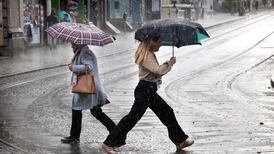So begins the publicity blurb for the latest episode of the Titanic saga, which continues to generate intrigue and emotion 86 years after the liner sank.
Tomorrow Mr Livingstone, chief naval architect of Harland & Wolff technical services in Belfast, will head a mission to the famous wreck site, more than 2 1/2 miles below sea level, for an unprecedented live TV broadcast. During a two-hour link-up with Discovery Channel, robot cameras will explore the ship's interior, and for the first time an attempt will be made to recover its Marconi wireless and passenger letters.
But the event, the centrepiece of a fourmonth expedition organised by the New York firm RMS Titanic Inc, has its critics. Many descendants of survivors and victims are concerned that lost passenger belongings are being plundered, despite assurances by the company that it would not remove anything inside the ship.
Condemning the successful recovery of a 20-tonne section of the hull last Tuesday, the niece of one crew member who survived has appealed for the wreck to be "left in peace".
It is the latest controversy surrounding the wreck. These stretch back to 1994 when RMS Titanic Inc, headed by Mr George Tullock, a former BMW dealer, was granted exclusive salvage rights by a US Federal Court. In a further judgment in 1996, the company succeeded in establishing a protection zone of several square miles around the ship within which access or photography was prohibited.
The ruling followed claims that the crew filming the wreck for James Cameron's blockbuster Titanic, had left debris on the ship and dislodged one of its skylights.
RMS Titanic Inc has already recovered nearly 5,000 artefacts which have been displayed in a travelling exhibition. It has pledged not to sell any recovered items, but that has not stopped many people from accusing the company of cashing in on tragedy.
"The Titanic seems to generate emotions quite unlike any other wreck," says Ed Coughlan, chairman of the Irish Titanic Historical Society. "There's a huge divergence of views about expeditions like this among societies, historians and even descendants of victims."
Much depends, he says, on whether items recovered are handled tastefully and sensitively. After a previous expedition, RMS Titanic Inc came under fire after it sold minute coal pieces taken from the debris for $25 each. The same items are now selling for more than $800, fuelling the demand for more Titanic merchandise.
"When it comes to the Titanic, some people seem to have more money than sense," Mr Coughlan says.
Some might think this group includes clients of Deep Ocean Expeditions, a British firm running day trips to the wreck in the same submersibles used in the movie Titanic at a cost of about £25,000 per person. Although the first leisure dives, scheduled for later this month, have been cancelled after RMS Titanic Inc was granted an injunction, the company is determined to go ahead with six expeditions in August 1999.
"There are some people who are just cashing in on the whole phenomenon without adding anything of value," says Mr Coughlan. In the case of RMS Titanic Inc's latest expedition, he says, evaluating its worth depends on which group of experts you believe.
The company, backed by two of the world's leading Titanic historians, Charles Haas and John Eaton, maintains the wreck is in danger of collapsing and its treasures should be recovered before they are lost for ever.
But Stephen Cameron, chairman of the Bangor-based Ulster Titanic Society in Co Down, says: "They would say that, wouldn't they? George Tullock has spent $20 million on the wreck and has recouped only $2 million."
Mr Cameron says he is concerned the collection of artifacts may in the future be sold or separated for financial reasons. "Someone described it as digging up grandpa to discover the wedding ring. There is an element of truth in that.
"George Tullock originally said he would not go into the ship. That's just forgotten about now. Our society would be concerned that this is going too far and before we know it everything will be brought up."
But in an indication of the kind of divisions which have emerged over the issue, just down the road Patrick Toms, founder of a rival Titanic society in Bangor, supports the latest expedition.
"There's nothing wrong in my mind with what they're doing. They are preserving artefacts for posterity," says Mr Toms, whose grandfather, Andrew John Shannon, was a Titanic quartermaster.
In its defence, RMS Titanic Inc says the latest expedition is not primarily about recovering items but about furthering knowledge of the tragedy.
According to Mr Livingstone "what happened to the ship from the time it hit the iceberg and went under the waves is reasonably well known. The value of this particular expedition is to find out what happened to the ship from the time that she was under the waves until she hit the seabed and also to try to explain and describe why she is in the condition she is in today."
In addition, as part of the live TV broadcast, areas previously unseen will be filmed for the first time. Remote-controlled cameras will travel into passenger areas, the captain's quarters and down one of the hatches into the lower cargo mail room.
The two-hour live broadcast from the Titanic can be seen on Discovery Channel at 7 p.m. tomorrow









